Top Qs
Timeline
Chat
Perspective
Tripeptidyl peptidase I
Protein-coding gene in the species Homo sapiens From Wikipedia, the free encyclopedia
Remove ads
Tripeptidyl-peptidase 1, also known as Lysosomal pepstatin-insensitive protease, is an enzyme that in humans is encoded by the TPP1 gene, also known as CLN2.[5][6] TPP1 should not be confused with the TPP1 shelterin protein which protects telomeres and is encoded by the ACD gene.[7] Mutations in the TPP1 gene leads to late-infantile neuronal ceroid lipofuscinosis.[8]
Remove ads
Structure
Gene
The human gene TPP1 encodes a member of the sedolisin family of serine protease enzymes. The human gene has 13 exons and locates at the chromosome band 11p15.[6] It is also known as CLN2, due to the relation to the disease.
Protein
The human TPP1 is 61kDa in size and composed of 563 amino acids. An isoform of 34.5kDa and 320 amino acids is generated by alternative splicing and a peptide fragment of 1-243 amino acid is missing.[9] TPP1 contains a globular structure with a subtilisin-like fold, a Ser475-Glu272-Asp360 catalytic triad. It also contains an octahedrally coordinated Ca2+-binding site that are characteristic features of the S53 sedolisin family of peptidases. Unlike other S53 peptidases, it has steric constraints on the P4 substrate pocket, which might contribute to its preferential cleavage of tripeptides from the unsubstituted N-terminus of proteins. Two alternative conformations of the catalytic Asp276 are associated with the activation status of TPP1.[10]
Remove ads
Function
High expression of TPP1 is found in bone marrow, placenta, lung, pineal and lymphocytes. The protease functions in the lysosome to cleave N-terminal tripeptides from substrates and has weaker endopeptidase activity.[10] It is synthesized as a catalytically inactive enzyme which is activated and autoproteolyzed upon acidification.
Clinical significance
The neuronal ceroid lipofuscinoses (NCLs) are a group of inherited neurodegenerative disorders with pathological phenotypes that auto fluorescent lipopigments present in neurons and other cell types. Bi-allelic mutations of the gene TPP1 have been found to result in one of these disorders, called late-infantile neuronal ceroid lipofuscinosis, also known as CLN type 2 or Jansky–Bielschowsky disease.[11] Mutations of gene is associated with the failure to degrade specific neuropeptides and a subunit of ATP synthase in the lysosome and accumulation of the fluorescent pigments.[12] The disease causes childhood onset neurodegeneration resulting in epilepsy, movement disorders and progressive loss of motor and cognitive skills.[13][14] Additionally, it causes retinal degeneration resulting in progressive loss of vision. Enzyme replacement therapy with cerliponase alfa can alter this course of disease, and is licensed for use in several countries.[15]
References
Further reading
External links
Wikiwand - on
Seamless Wikipedia browsing. On steroids.
Remove ads








